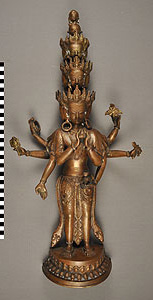Figurine: Boddhisattva of Mercy, Avalokitesvara
1985.17.0001
Detailed Images
Basic Information
| Artifact Identification | Figurine: Boddhisattva of Mercy, Avalokitesvara (1985.17.0001) |
|---|---|
| Classification/ Nomenclature |
|
| Artist/Maker | Unknown |
| Geographic Location | |
| Period | Ming Dynasty (1368-1644) |
| Date | 15th – 16th century |
| Culture | Chinese, Tibetan |
| Location | Not on Exhibit |
Physical Analysis
| Dimension 1 (Height) | 62.3 cm |
|---|---|
| Dimension 2 (Width) | 30.8 cm |
| Dimension 3 (Depth) | 10.0 cm |
| Weight | 4486 g |
| Measuring Remarks | N/A |
| Materials | Metal--Bronze |
| Manufacturing Processes | Cast, Chased |
Research Remarks
| Description | N/A |
|---|---|
| Published Description | Under Review |
| Bibliography | Jansen, Eva Rudy. The Book of Buddhas: Ritual Symbolism used on Buddhist Statuary and Ritual Objects. Diever, Holland: Binkey Kok Publications, 1990. |
Artifact History
| Credit Line/Dedication | Gift of Betty Ann Knight in Memory of Mrs. A. R. Knight |
|---|---|
| Reproduction | No |
Contact
All information about our collection is constantly reviewed and updated. Please contact Dery Martínez-Bonilla, Registrar, if there is any information you are looking for that isn't currently online.
